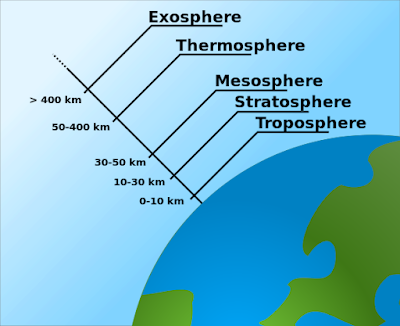On the basis of the characteristics of temperature and air pressure, the earth's environmental envelop is divided into 5 layers as
- Troposphere
- Stratosphere
- Mesosphere
- Ionosphere
- Exosphere.
Will see each of these below in brief.
1. Troposphere
- It is the lowermost and the most important layer of the atmosphere, as almost all the weather phenomena occur in this layer.
- It extends from the earth's surface up to 8 km over the pole and 18 km over the equator which means, Troposphere is thick over the equator than over the pole. The first 1.5 to 2 km height of the troposphere is called the friction layer.
- At the end of the troposphere, tropopause is located. Temperature at tropopause is -45°C over the pole and -80° over the equator.
- In this layer, temperature decreases with increasing altitude at the rate of 1°C/165 m or 6.5°C/1000m. this average rate of decrease in temperature is called the Normal lapse rate.
- About 75% mass of environmental gases and about 99% mass of water vapor and dust particles are located within the layer. It means, this layer contains most of the clouds.
- The troposphere is not suitable for flying aircraft, because bumpy air pockets are present in this layer.
2. Stratosphere:
- It extends from tropopause up to 50 km of height. It extremely dry region and almost no clouds are present in it except cirrus and mother of pearl clouds.
- The temperature remains stable at the beginning of this layer but it suddenly starts changing after the height of 20 km. This sudden change in temperature is due to the presence of the Ozone layer (30 to 50 km) in the upper layer of the stratosphere, which absorbs the ultraviolet radiations present in solar radiation. At the end of the stratosphere, the temperature becomes 0°C.
- The stratosphere is suitable for flying aircraft because this layer is almost free from weather disturbances.
3. Mesosphere:
- It extends from 50km to 80km in height.
- In this layer, temperature decreases with height and at the end of this layer temperature becomes -100°C, which is the minimum temperature of the atmosphere.
4. Ionosphere:
- It extends from 80 km to 400 km in height it is the thickest above all layers. the ionosphere is divided into various layers such as D, E, F1, F2, etc. The upper part of the ionosphere is called as Thermosphere.
- The temperature in this layer and subsequent layers over it constantly rises with height and becomes 1000°C at the end of this layer.
- In this layer, most of the gases are present in an ionized state and electrical conductivity is responsible for reflecting the radio waves and other electromagnetic weaves back to the earth's surface.
- Most of the heavenly bodies such as meteorites when entering into the earth's environment get burnt in this slayer due to ionized friction.
5. Exosphere:
- It extends beyond 400 km in height. The upper part of the exosphere is called Magnetosphere.
- the temperature keeps on rising constantly at a high rate.
- Practically earth's environment extends up to 36000 km when the earth loses its gravity effect.


Post a Comment
Post a Comment